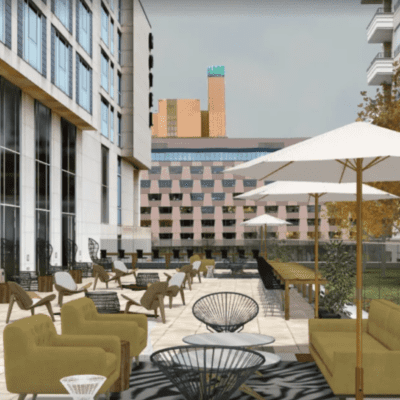 Bleisure has become a booming customer segment for hotels. “Bleisure” is a portmanteau of the words business and leisure, and refers to corporate travellers which also add leisure activities into their stay. It is also known as “bizcation” or “workcation”. The typical question that guests are asked, “Are you traveling for business or leisure?” will likely soon require the third option of bleisure. Discover how to attract bleisure guests to your hotel in this brief 5-step guide for hotel operation, revenue management, and hotel marketing professionals.
Bleisure has become a booming customer segment for hotels. “Bleisure” is a portmanteau of the words business and leisure, and refers to corporate travellers which also add leisure activities into their stay. It is also known as “bizcation” or “workcation”. The typical question that guests are asked, “Are you traveling for business or leisure?” will likely soon require the third option of bleisure. Discover how to attract bleisure guests to your hotel in this brief 5-step guide for hotel operation, revenue management, and hotel marketing professionals.
What type of guest profiles cover bleisure travelers?
Bleisure travelers usually hold executive and management positions in the corporate sector, in companies ranging from SMEs to multinationals. However, with the rise of remote and freelance work, and the increasing popularity of becoming a “digital nomad” and working in coworking offices, bleisure also extends to this profile. Depending on your target guest persona, you can tailor your offering to each type of bleisure profile.
These may include the high-income corporate executive, from 35 to 60 years old, male or female; the digital nomad with varying degrees of disposable income, from 25 to 40 years old, male or female; and the startup founder with considerable spending power, from 35 to 50 years old, usually male but increasingly female.
Crucially, these roles are populated more and more by the millennial generation, and also now, Generation Z. These are generations that are more digital-savvy and take more business trips, averaging 7.4 per year (Matadornetwork, 2019). And with greater work-leisure flexibility offered by companies, in response to demands from millennials and generation Z, it is much easier for professionals to travel than in previous years.
Added to this the rise in budget travel and the ease of working remotely, as usually with a laptop, smartphone, and good internet access, bleisure guests are fully equipped and ready for work wherever they are.
What does the growth of bleisure mean for hotels?
According to research by Expedia Group Media Solutions (2018), 60% of corporate guests prolong their stays to add leisure activities on top of their professional obligations, whereas 57% of bleisure travellers spend the same or more as on a regular vacation trip.
Proactive hotels have been catering to the ballooning bleisure market already, aware of its increasing importance. Crucially, a lot of bleisure guests are high-income customers, and typically travel and spend on a corporate credit card for work-related expenses. For leisure activities, they typically have high disposable income, so all in all, they are guests of extreme importance for hotels eager to maximize revenues.
 How to attract bleisure travelers for your hotel: a 5-step practical tip plan
How to attract bleisure travelers for your hotel: a 5-step practical tip plan
1. Offer short-stay bleisure packages
50% of business trips that last two to three nights are most likely to turn into bleisure trips (Expedia research). Therefore, you can make your hotel stand out from competitors by offering special short-stay packages that appeal to the flying visit bleisure traveler and include deals and feature highlights.
You can also aim to attract bleisure guests to stay extra nights with incremental discounts, such as 10% off for an extra night, and 20% for two extra nights.
2. Focus on the most important business traveler services
Guests who travel for business tend to look for a number of features in the ideal hotel. These include high speed and free internet, co-working space, meeting room availability, lots of power outlets, proximity to important business centers, and ease of travel.
You can enhance your offering too though by including add-on service like clothes ironing on-site, room service, including both dinner and breakfast, and on-site fitness suite use. And more often, bleisure travelers want fast, easy check-in and check-out capabilities. Hotels are responding to this demand with apps that do exactly this, as well as for managing bookings in a personalized way.
3. Include enticing leisure services
This can include features aimed at relaxation and entertainment. For instance, a bleisure package offer could include all-stay spa access, a range of professional massage options, and in-demand holistic therapy practices, such as reiki and acupuncture. Your hotel can also offer popular fitness classes, including yoga and pilates. Entertainment options might include an on-site cinema or movie room, after-work cocktails, or live music.
You can also develop agreements with local entertainment and tourism businesses. This could include tour guides, cultural experiences, visits to local landmarks and offers with possible discounts for local activities, like deep-sea diving, mountain climbing, or guided hikes.
4. Aim for a hyper-personalised experience
What appeals to one bleisure traveler may not appeal to another. In fact, 86% (Kahuna, 2019) of hotel guests say that personalization helps them to make their decision when choosing a hotel (Booking.com). But you can make your hotel even more appealing by taking personalization hyper. Hyper-personalization refers to the harnessing of guest preference data at a granular level to offer the most tailored hotel experience that they could hope for. You can incorporate this type of service by using different types of data.
This includes basic information, such as preferred contact methods, purpose of travel and so forth. You can also gather personal profile data, such as preferred language, age group and gender. Then you are in a position to really get to know your guest before they arrive.
You can contact them through their preferred method of communication to ask for specific preferences, such as food and drink, taxi reservation requests, room service requests, specific room preferences, and so forth. Hotels are increasingly using chatbots and pre-check-in surveys to glean such information.
5. Encourage repeat stays
By using technology that enables you to offer a personalized service, you can also understand what services and products business leisure travelers used and enjoyed. This allows you to identify cross-selling opportunities, and also to see what they may have missed out on but would have enjoyed. You can then use this information to include in a repeat-stay package offer.
Moreover, you can tempt your bleisure guests with exclusive loyalty rewards for returning customers, such as discounts, freebies, off-peak special prices. You can also offer incentives for colleague referrals, including discounts off future stays.
When developing a strategy for how to attract bleisure guests to your hotel, taking a comprehensive viewpoint by not only aiming to get bleisure guests through the door but to turn them into loyal, repeat customers who sing your hotel’s praises to their business colleagues will help you to maximize your success in the short, medium and long term.
Becoming a bleisure-centric hotel: the final word
Bleisure is still a relatively nascent trend in the hotel sector. Given how much it is growing, this is wonderful news for hotels that are interested in appealing to this group. The sky is truly the limit for bleisure, with business travel estimated to grow to $1.6 trillion by 2020 according to the latest BTI outlook of Global Business Travel Association’s (GBTA research), and the continuing blurring of the lines between business and leisure in general. Now is the time for your hotel to jump on this booming trend and position it as your city’s bleisure hotel of choice by following those 5 steps for your hotel operation, revenue management and marketing team.


 How to attract bleisure travelers for your hotel: a 5-step practical tip plan
How to attract bleisure travelers for your hotel: a 5-step practical tip plan

















